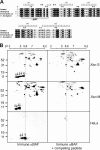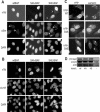Barrier-to-autointegration factor phosphorylation on Ser-4 regulates emerin binding to lamin A in vitro and emerin localization in vivo
- PMID: 16371512
- PMCID: PMC1382305
- DOI: 10.1091/mbc.e05-04-0356
Barrier-to-autointegration factor phosphorylation on Ser-4 regulates emerin binding to lamin A in vitro and emerin localization in vivo
Abstract
Barrier-to-autointegration factor (BAF) is a conserved 10-kDa chromatin protein essential in proliferating cells. BAF dimers bind double-stranded DNA, histone H3, histone H1.1, lamin A, and transcription regulators, plus emerin and other LEM-domain nuclear proteins. Two-dimensional gel analysis showed that endogenous human and Xenopus BAF are posttranslationally modified by phosphorylation and potentially other modifications and that they are hyperphosphorylated during mitosis. The invariant Ser-4 residue on BAF is a major site of phosphorylation during both interphase and mitosis. In HeLa cells that overexpressed the phosphomimetic BAF missense mutant S4E, but not S4A, emerin mislocalized from the nuclear envelope, suggesting Ser-4-nonphosphorylated BAF normally promotes emerin localization at the nuclear envelope. Supporting this model, wild-type BAF but not mutant S4E enhanced emerin binding to lamin A in vitro. Thus, Ser-4-unphosphorylated BAF has a positive role in localizing emerin; this role may be disease relevant because loss or mislocalization of emerin causes Emery-Dreifuss muscular dystrophy. Our findings further suggest Ser-4 phosphorylation inhibits BAF binding to emerin and lamin A, and thereby weakens emerin-lamin interactions during both mitosis and interphase.
Figures






Similar articles
-
Distinct functional domains in emerin bind lamin A and DNA-bridging protein BAF.J Cell Sci. 2001 Dec;114(Pt 24):4567-73. doi: 10.1242/jcs.114.24.4567. J Cell Sci. 2001. PMID: 11792821
-
Transcriptional repressor germ cell-less (GCL) and barrier to autointegration factor (BAF) compete for binding to emerin in vitro.J Biol Chem. 2003 Feb 28;278(9):6969-75. doi: 10.1074/jbc.M208811200. Epub 2002 Dec 18. J Biol Chem. 2003. PMID: 12493765
-
BAF is required for emerin assembly into the reforming nuclear envelope.J Cell Sci. 2001 Dec;114(Pt 24):4575-85. doi: 10.1242/jcs.114.24.4575. J Cell Sci. 2001. PMID: 11792822
-
Nuclear membrane protein emerin: roles in gene regulation, actin dynamics and human disease.Novartis Found Symp. 2005;264:51-58; discussion 58-62, 227-30. Novartis Found Symp. 2005. PMID: 15773747 Review.
-
A lamin-dependent pathway that regulates nuclear organization, cell cycle progression and germ cell development.Novartis Found Symp. 2005;264:231-40; discussion 240-5. Novartis Found Symp. 2005. PMID: 15773757 Review.
Cited by
-
Barrier to Autointegration Factor (BANF1): interwoven roles in nuclear structure, genome integrity, innate immunity, stress responses and progeria.Curr Opin Cell Biol. 2015 Jun;34:61-8. doi: 10.1016/j.ceb.2015.05.006. Epub 2015 Jun 10. Curr Opin Cell Biol. 2015. PMID: 26072104 Free PMC article. Review.
-
Orchestrating nuclear envelope disassembly and reassembly during mitosis.Nat Rev Mol Cell Biol. 2009 Mar;10(3):178-91. doi: 10.1038/nrm2641. Nat Rev Mol Cell Biol. 2009. PMID: 19234477 Review.
-
Caenorhabditis elegans BAF-1 and its kinase VRK-1 participate directly in post-mitotic nuclear envelope assembly.EMBO J. 2007 Jan 10;26(1):132-43. doi: 10.1038/sj.emboj.7601470. Epub 2006 Dec 14. EMBO J. 2007. PMID: 17170708 Free PMC article.
-
Emerin Is Required for Proper Nucleus Reassembly after Mitosis: Implications for New Pathogenetic Mechanisms for Laminopathies Detected in EDMD1 Patients.Cells. 2019 Mar 13;8(3):240. doi: 10.3390/cells8030240. Cells. 2019. PMID: 30871242 Free PMC article.
-
Exploring Virus-Host Interactions Through Combined Proteomic Approaches Identifies BANF1 as a New Essential Factor for African Swine Fever Virus.Mol Cell Proteomics. 2025 Jul 22;24(9):101038. doi: 10.1016/j.mcpro.2025.101038. Online ahead of print. Mol Cell Proteomics. 2025. PMID: 40707000 Free PMC article.
References
-
- Bengtsson, L., and Wilson, K. L. (2004). Multiple and surprising new functions for emerin, a nuclear membrane protein. Curr. Opin. Cell Biol. 16, 73–79. - PubMed
-
- Bradley, C. M., Ronning, D. R., Ghirlando, R., Craigie, R., and Dyda, F. (2005). Structural basis for DNA bridging by barrier-to-autointegration factor. Nat. Struct. Mol. Biol. 12, 935–936. - PubMed
-
- Broers, J. L., Hutchison, C. J., and Ramaekers, F. C. (2004). Laminopathies. J. Pathol. 204, 478–488. - PubMed
-
- Cai, M., Huang, Y., Zheng, R., Wei, S. Q., Ghirlando, R., Lee, M. S., Craigie, R., Gronenborn, A. M., and Clore, G. M. (1998). Solution structure of the cellular factor BAF responsible for protecting retroviral DNA from autointegration. Nat. Struct. Biol. 5, 903–909. - PubMed
-
- Casaday, R. J., Bailey, J. R., Kalb, S. R., Brignole, E. J., Loveland, A. N., Cotter, R. J., and Gibson, W. (2004). Assembly protein precursor (pU.L80.5 homolog) of simian cytomegalovirus is phosphorylated at a glycogen synthase kinase 3 site and its downstream “priming” site: phosphorylation affects interactions of protein with itself and with major capsid protein. J. Virol. 78, 13501–13511. - PMC - PubMed
Publication types
MeSH terms
Substances
Grants and funding
LinkOut - more resources
Full Text Sources
Molecular Biology Databases

